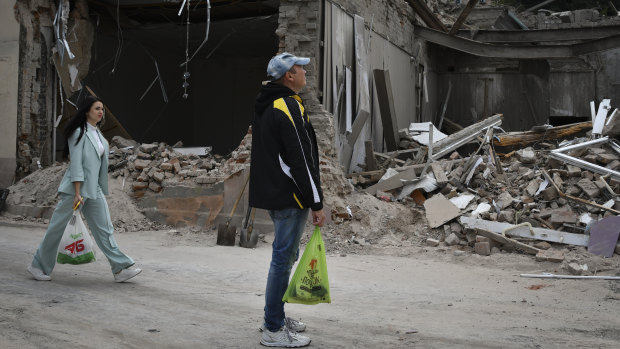But running a big budget deficit does increase overall demand in the economy, which is inflationary, especially if supply is simultaneously being reduced — for example, by Russian missile strikes. If borrowing to cover the deficit is difficult — which it often is in wartime — some of the gap may also be covered by printing money. So it’s normal and even acceptable to see significant inflation in times of war.
Loading
World War II, by the way, is the exception that proves the rule. Despite gigantic budget deficits and the diversion of much of the economy’s capacity to war production, the US government mostly kept a lid on inflation, partly via price controls and partly via rationing and other controls that suppressed private demand. Even then, there was a postwar spike in prices when those controls were removed.
Wars bring on inflation
If we look at earlier episodes, however, wars were regularly accompanied by inflation. During World War I, for example, Britain and the United States experienced inflation not far short of what Ukraine is experiencing now, even though neither was invaded.
Or look at the American Civil War. The Union experienced Ukraine-like inflation. The Confederacy, whose military situation more closely resembled that of contemporary Ukraine — even though Ukraine is defending freedom, while America’s South was defending slavery — experienced runaway inflation.
So Ukraine is actually doing pretty well, considering. Why?
Part of the answer is that on the economic front, as in the military struggle, the Ukrainians have shown an unexpected level of coolheadedness and competence. They quickly imposed capital controls to prevent a massive flight of money from the country and also intervened to stabilise the foreign exchange value of their currency — something that isn’t always a good idea, but in this case helped prevent an inflation panic.

Destruction everywhere: It makes sense to focus more on the country’s economy now that the tide seems to have turned in Ukraine’s favour on the battlefield.Credit:AP
But none of this would have mattered — just as the battlefield courage of the Ukrainians wouldn’t have mattered — were it not for the fundamental fact that Ukraine isn’t standing alone.
On its own, Ukraine is hugely outmatched economically by Russia, which is one reason Russia appeared to have overwhelming military superiority. But the combined economic weight of the countries backing Ukraine makes the Russian economy look puny, and diverting even a small fraction of these countries’ resources to helping Ukraine utterly shifts the balance of power.
This has been obvious on the battlefield, where Western weapons have changed everything. It’s also true on the economic side, where Western loans and aid are helping Ukraine contain the fallout from the military struggle.
Western weapons
The key question now is whether this aid, both military and financial, will be provided on a sufficient scale to ensure Ukraine’s survival and — as some of us hope — victory.
As I see it, there were four ways Russian President Vladimir Putin might have won:
First, the Russians might have succeeded in a quick decapitating strike, seizing Kyiv and overthrowing Ukraine’s government at a stroke. Indeed, they tried to do that — and, as I read in news accounts, came dangerously close to success. But they failed, and the battle of Kyiv, Ukraine’s capital, turned into a Russian debacle.
Loading
Second, the Russians might have pulled off a World War II-style envelopment in the Donbas, encircling a large part of Ukraine’s army and then driving on to Kyiv. But they were thwarted by Ukrainian valour and stubbornness.
After that, there was still a chance that Russia would prevail through a battle of attrition, grinding down Ukraine’s army with artillery barrages until it finally broke. Things did indeed look grim for a time; we now know that there was a critical moment in June when Ukraine was effectively out of artillery ammunition.
But the arrival of Western weapons — above all, those HIMARS launchers that keep destroying Russian ammo dumps and command centres — turned the tide. (I still find it amazing how much damage appears to have been done by just 16 US-supplied HIMARS launchers and 10 older systems from Britain and Germany.) At this point, Russia’s army seems more likely to break than Ukraine’s.
This leaves one remaining path to Russian victory: dwindling Western support, both military and economic. If the flow of weapons slows down, Ukraine will once again find itself outmatched.
If the flow of money is insufficient (some European nations have yet to deliver much of what they promised), Ukraine’s economy will fall into crisis.
This is why Ukraine’s successful counterattack near Kharkiv matters so much. Neither the territory gained nor the losses inflicted will do much to shift the military balance. But by demonstrating their capabilities and Russian weakness, the Ukrainians are trying to refute Western officials who still don’t believe they can win and, hence, keep the guns and money coming.
This article originally appeared in The New York Times
The Business Briefing newsletter delivers major stories, exclusive coverage and expert opinion. Sign up to get it every weekday morning.
Stay connected with us on social media platform for instant update click here to join our Twitter, & Facebook
We are now on Telegram. Click here to join our channel (@TechiUpdate) and stay updated with the latest Technology headlines.
For all the latest Business News Click Here
For the latest news and updates, follow us on Google News.
